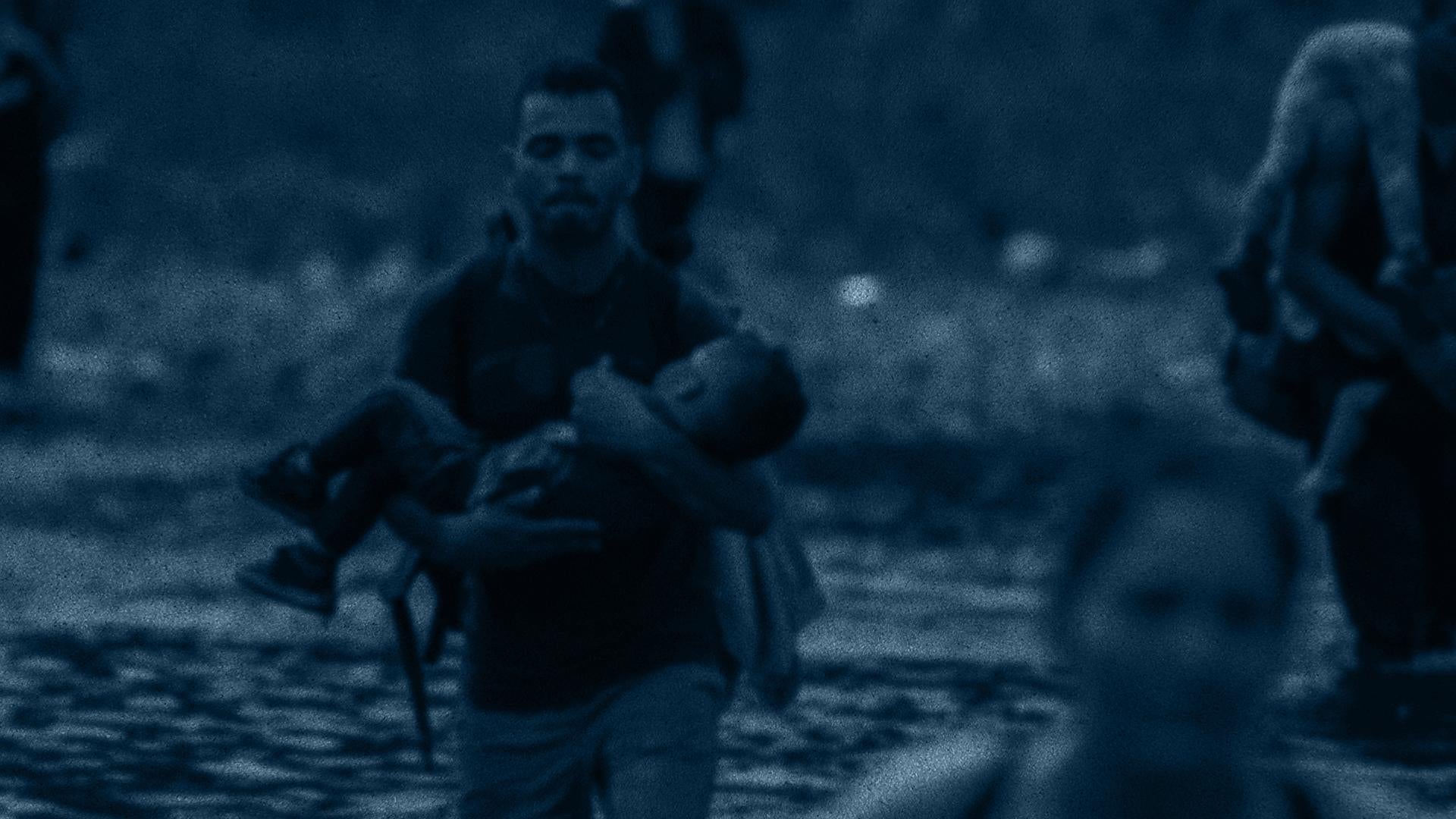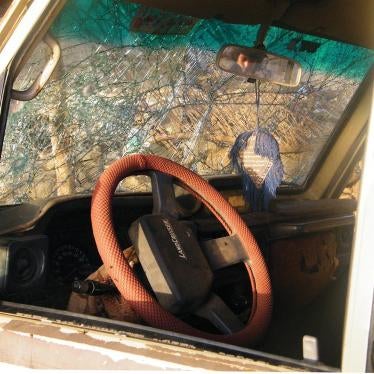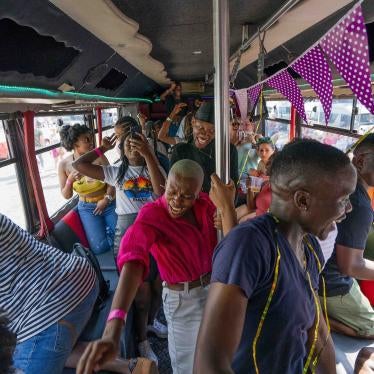(Jerusalem) – Israeli troops appear to have used unlawful lethal force during an arrest raid in a Palestinian refugee camp that killed three Palestinians. The raid on August 26, 2013, and the response to subsequent disturbances in the camp also injured 19, including the target of the arrest, Yusuf al-Khatib, who was wanted in relation with unspecified “terrorist activities.”
Residents of the Qalandia refugee camp responded to the arrest raid by throwing stones at Israeli soldiers, who initially responded by firing tear gas and rubber bullets. As clashes spread, a larger number of camp residents threw stones, Molotov cocktails and other objects, and Israeli forces used live ammunition as reinforcements arrived, witnesses said. In several cases, soldiers shot Palestinians who were not throwing stones in circumstances indicating that they intentionally used lethal force that was not necessary to protect life, in violation of international standards.
“Israeli forces confronted stone-throwing and mayhem during the raid on Qalandia but that doesn’t justify shooting Palestinians who posed no threat,” said Joe Stork, acting Middle East director at Human Rights Watch. “The results are shattered lives, shattered limbs, and shattered families – and a need for criminal investigations.”
Israeli soldiers who shot people unlawfully should be prosecuted. According to international standards,Israelshould also grant victims and their families access to an independent, judicial process to seek compensation.
Israeli forces allegedly beat the target of the arrest severely, breaking his nose and teeth, and assaulted a relative without justification.
Human Rights Watch examined the locations of the three killings and spoke with 16 camp residents who said they witnessed the incidents, including five who had been shot, and compared their accounts with information collected by Israeli and Palestinian human rights groups and international organizations.
According to information provided to Human Rights Watch by staff at the Ramallah hospital, 5 of the 18 people wounded by gunfire during the clashes were under 18 years old, and 12 of the 18 required surgery.
In a statement released on the day of the incursion, the Israeli military said that the results of a “preliminary” inquiry by its Central Command indicated that Israeli forces had acted “according to orders and in a restrained and proportionate manner,” and had used live ammunition in self defense because they felt threatened by the crowds. According to the statement, “there was live fire in the direction of our forces, and we located four bullets in a vehicle that was escorting the force.”
All camp residents whom Human Rights Watch interviewed denied that any Palestinians had used live fire, or said they were unaware of it happening. Israel should make public any evidence of use of live fire by Palestinians and clarify the circumstances warranting the use of lethal force pursuant to the military’s rules of engagement, Human Rights Watch said.
Israeli forces conducting policing operations in occupied territory are subject to the international standards set out in the United Nations Basic Principles on the Use of Force and Firearms by Law Enforcement Officials. According to these standards, law enforcement officials may make “intentional lethal use of firearms” only when it is “strictly unavoidable in order to protect life.”
Please see below for more information.
The Arrest Raid
Israeli news reports said that according to the military’s initial inquiry, an undercover Border Guard force entered the refugee camp at around 5:30 a.m. on August 26 in order to arrest a wanted suspect, and later called in a backup force from the Artillery Corps after clashes began with camp residents.
Witnesses told Human Rights Watch that by around 5:45 to 6 a.m., undercover forces dressed in civilian clothes had entered the home of Yusif al-Khatib, the target of the arrest operation, and that uniformed soldiers were also present on the street outside his home.
Israeli forces had raided the camp on two prior occasions in July and August in failed attempts to arrest al-Khatib, who had previously been jailed by Israel and released. Israeli spokespersons have not specified why al-Khatib was wanted beyond alleging his implication in “terrorist activities.”
Israeli forces inside al-Khatib’s home ordered all the residents into one room. They blindfolded and “zip-tied” O., a relative of al-Khatib’s, who told Human Rights Watch:
They thought I was Yusif. They drove me to the military base near al-Ram [a nearby Palestinian neighborhood] and pushed me onto the floor of the vehicle with my back on the ground. One of them was hitting me in the stomach all the way there with a heavy object, maybe a fire extinguisher.
At the base, he said, a “captain removed my blindfold and said he was sorry they had arrested me, because now they had found Yusif, and they drove me back home to identify him.” O. said that soldiers took him to a neighbor’s home, where al-Khatib had been apprehended. “I could barely recognize him. They had broken his nose and knocked out his teeth, and his hand was broken,” he told Human Rights Watch.
Israeli forces then took al-Khatib outside, put him in a military vehicle and drove away. O. said this occurred between 7:30 and 8 a.m. Al-Khatib is currently detained at the Ofer detention center and military court complex.
Clashes in Qalandia Camp
Men and youths in the area around al-Khatib’s home had begun throwing rocks at soldiers in the street soon after the soldiers arrived, at around 6 a.m. Soldiers initially responded with teargas and rubber bullets. Clashes escalated from 6 a.m. until around 6:45, when more troops arrived. Witnesses said that by 7 a.m., around eight military vehicles and a large number of soldiers on foot had entered the camp and were stationed on al-Khatib’s street, on the camp’s main east-west road, and on rooftops, and were firing live ammunition.
Youth from the camp dragged two large metal garbage containers into the road behind the soldiers to block their withdrawal back to the main north-south street on the camp’s western side, and threw rocks, Molotov cocktails and other objects at them from side streets and rooftops. Witness statements indicate that Israeli forces fired a large number of live rounds. Human Rights Watch counted 26 bullet holes in one side of one building, which residents said Israeli forces had fired during the August 26 raid.
Use of Live Ammunition
The injuries and killings that Human Rights Watch documented all apparently occurred at around 7 a.m. or shortly afterwards, according to witnesses. Evidence in at least some cases strongly suggests that the use of live ammunition was not justified. All of the incidents detailed below warrant further investigation; cases in which lethal force was used without adequate justification should be criminally prosecuted.
Israeli forces stationed outside al-Khatib’s home, on a small side-street parallel to the camp’s main road, shot and injured Abu Murad, 50, a garbage collector employed by the United Nations Relief and Works Agency for Palestine Refugees (UNRWA), witnesses said. Residents of the area told Human Rights Watch that at around 7:15 or 7:30 a.m., before Israeli forces had captured al-Khatib, Abu Murad had left his trash-collecting wagon at the eastern end of the side-street, when he saw soldiers standing in front of al-Khatib’s home, about 50 meters down the street to the west. He retreated around a corner, then returned to retrieve the wagon, and a soldier shot him in the back of his lower leg.
A witness who asked not to be identified said he did not hear the shot but saw Abu Murad fall, ran to help drag him away, and saw a soldier in front of al-Khatib’s home looking at them. Another witness said there was a single shot, which he believed indicated that the soldier had aimed deliberately at Abu Murad. Residents said that young men on rooftops were throwing stones at Israeli forces at the opposite, western end of the street, throughout the clashes. However, both witnesses to Abu Murad’s shooting said they did not see anyone throwing stones at the Israeli forces from Abu Murad’s direction in the street at that time.
Israeli forces remained inside and in front of al-Khatib’s house until they arrested him at a neighbor’s house at some point between 7:30 and 8 a.m., and then drove away with him in custody. At least one military vehicle drove west a short distance down the side street before turning south into another small street leading to the camp’s main road. A group of Palestinians not involved in the clashes slowly walked in the same direction after the Israeli forces withdrew around the corner, believing the clashes were over in the immediate area, residents said.
Two witnesses said that Israeli forces shot Roubin Abd al-Rahman Zayed, 34, in the chest, after the military vehicles had driven away from al-Khatib’s home. Multiple witnesses said that Zayed, who worked as a cleaner at an UNRWA training center in the camp, had not participated in the clashes, and had been waiting in an area to the east of al-Khatib’s home for the clashes to end and Israeli forces to depart in order to go to work.
One of the witnesses told Human Rights Watch:
[Zayed] and I were at the head of a group waiting to get around the corner. Roubin wanted to go to work. The [military vehicles] had left from in front of [al-Khatib’s] house and the last one was around the corner and half-way down to the main road when a soldier who was about to get into the back of the vehicle shot Roubin. There were no other soldiers still on the street. It was the last [vehicle] pulling away, the last soldier and the last shot.
The second witness, interviewed separately, who also asked not to be identified, said:
Roubin thought he was safe, he’d been hiding behind the corner. People were telling him it wasn’t safe. He got out and they shot him in the chest. He was just walking, not running. I was standing on the roof and saw it. Have you seen a video game where the blood spatters? It was like that, at close range. I ran down, we grabbed him and took him down the road to get a car. No way did they hit him by accident.
Both witnesses to Roubin Zayed’s shooting identified the locations where the military vehicle and Zayed were at the time of the shooting, about 25 meters apart. There is a clear line of sight to the location where the witnesses said Zayed was shot.
Youths had thrown rocks at Israeli forces on the same street prior to Zayed’s death; for instance, Human Rights Watch interviewed A.,20, who had a bullet lodged in the bone of his lower leg after being shot at around 7 a.m. while trying to throw a rock. This was just “up the hill from the place where Roubin was killed later,” he said. However, according to two witnesses as well as another resident of the area, at the time the soldier shot Zayed no camp residents were throwing rocks near or behind him. “There were guys throwing rocks from the rooftops at the intersection, but none were in the street between Roubin and the [vehicle] or behind him,” the first witness said.
I.,20, said that he had been shot that morning in the abdomen while throwing stones, and was being driven to hospital in a neighbor’s car when “someone said, ‘take another wounded with you,’ and they put in Roubin. He wasn’t moving. He’d been shot in the chest, with blood coming out of his mouth.”
Fire Against People Throwing Objects
Human Rights Watch documented other cases where Israeli forces shot live ammunition at men and children who were throwing stones and other objects at soldiers and military vehicles. Based on witness accounts, the forces frequently used live ammunition in response to clashes after 7 a.m. One youth, Y., 17, who was using crutches, said that a live bullet fired by Israeli forces had entered and exited his left thigh at around 7:30 a.m. while he was “throwing rocks at the jeeps” on the camp’s main road.
Israeli forces shot Yunis Jamal Jahjouh, 22, twice as he stood on the roof of a one-story building on the south-western side of the intersection of the main camp road and a smaller road leading north to the home of al-Khatib, witnesses said. Two witnesses told Human Rights Watch that Jahjouh was attempting to throw a satellite dish at military vehicles in the street below when he was killed. One witness, T., 18, said, “he was thrown off balance by the satellite dish. He was shot once, and said ‘Allahu Akhbar,’ and then he was shot again. There were two people with Yunis on the roof, but there was no way to get him down and out of there because of the clashes. He bled out until they got him to the ambulance, and it was too late.” According to a statement by the Palestinian hospital in the city of Ramallah, Jahjouh suffered gunshot wounds to the chest and stomach.
Further east along the main camp road, Israeli forces shot and killed Jihad Mansour Aslan, 21, as he was standing on the corner of the roof of a one-story building on the southern side of the road. A relative told Human Rights Watch:
I had been with Jihad on the roof when the [soldiers] started shooting intensively at us and we scattered. There were eight or nine of us. I jumped down and was shouting at Jihad to get back from the front of the building. He was shot the first time in his hand, and then he picked up a rock and they shot him again. We went to get him and brought him down. There was a lot of blood. We put him in a civilian car. He was still alive but he wasn’t speaking. The bullet hit him in the chest and went out his back.
The Israeli authorities should immediately open criminal investigations into the Qalandia shootings, Human Rights Watch said. Under the UN principles on the right to a remedy for human rights violations, states have the duty to investigate and, if there is sufficient evidence, the duty to submit to prosecution the person allegedly responsible for the violations and, if found guilty, the duty to punish her or him.
The Israeli military has a poor record of accountability. Since the beginning of the second Palestinian intifada in 2000, Israeli military courts have convicted only six Israeli soldiers for offenses involving the deaths of Palestinians, and one soldier for the death of a British citizen, according to Yesh Din, an Israeli rights group. Israeli investigations into the raid in the Qalandia camp should be prompt, thorough and impartial.








